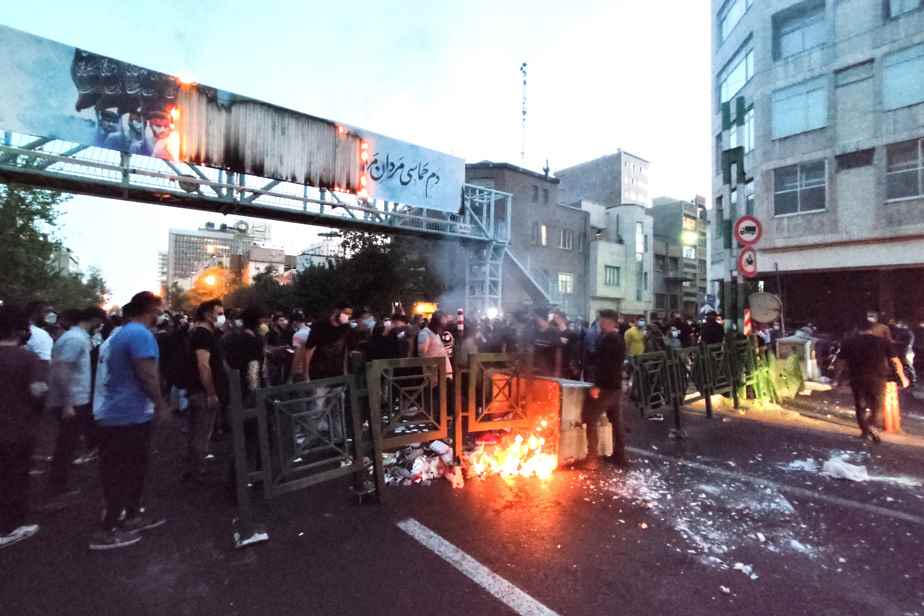(Paris) Security forces fired live ammunition on Monday to quell protests in Kurdish areas of western Iran, Norway-based Iranian Kurdish rights group Hengaw said.
The group reported 13 deaths in 24 hours in these regions, but this figure could not be immediately verified.
Hengaw posted videos she said showed law enforcement firing live ammunition in the towns of Piranchahr, Marivan and Javanroud.
Reinforcements have been sent in recent days to the Kurdish regions, one of the centers of the protest movement sparked on September 16 by the death of Mahsa Amini, a 22-year-old Iranian Kurd arrested by the morality police for breaking the code strict dress code requiring women to wear the veil in public.
Demonstrations there have recently intensified, particularly during the funerals of demonstrators killed by the security forces.
According to Hengaw, at least seven people were killed in Javanroud, four in Piranchahr and two in other localities.

PHOTO PROVIDED, VIA AGENCE FRANCE-PRESSE
Protesters and members of the security forces in Javanroud, where seven people were reportedly killed by live ammunition on Monday.
The Oslo-based NGO Iran Human Rights (IHR) also posted footage it said showed security forces firing live ammunition in Piranshahr and a mother’s grief over the remains of a teenage boy. 16 years old killed on Sunday, just before his funeral.
“Mother, don’t cry, we are going to take revenge”, shouted in Kurdish people present at her side, according to the NGO.
disrupted internet
Another video posted by Hengaw shows what the group portrays as residents of Javanroud trying to evacuate a body in a street trying to protect themselves from gunfire.
Other images show heavily armed security forces moving from the city of Sanandaj, the capital of Kurdistan province, to those of Mahabad and Boukan.
The New York-based NGO Center for Human Rights in Iran (CHRI) referred to “incessant shooting and images of bloody people being evacuated to safety” in Javanroud.
NetBlocks, which monitors internet blockages around the world, reported on Monday a “significant disruption” to internet access during the latest protests, stating that “access to mobile internet was cut for many users.
US Secretary of State Antony Blinken said on Twitter that he was “greatly concerned that Iranian authorities are stepping up violence against protesters, especially in Mahabad”, in West Azerbaijan province.
In Doha, the 11 Iranian players refrained from singing their national anthem before their first match of the World Cup-2022.
The slogan symbol of the movement, “Women Life Freedom”, appeared before kick-off on a banner in a bend of the stadium occupied by the Iranians, before disappearing. “Azadi!” Azadi! (“Freedom! Freedom!”) also sometimes rose from the stands.
Strikes in Iraq
The Kurds represent one of the main ethnic minorities in Iran – about 10 million out of 83 million inhabitants – and mainly adhere to Sunni Islam and not to the dominant Shiism in the country.
At least 378 people have been killed in the crackdown on protests, according to a latest IHR report.
Among them, 255 died during protests linked to the death of Mahsa Amini and 123 in the province of Sistan-Baluchistan (southeast), including more than 90 on September 30 in the provincial capital Zahedan, during demonstrations against rape of a teenager attributed to a police officer.
On Monday, a policeman was killed and another injured by gunfire from “criminals” in Zahedan, General Mohammad Ghanbari, the provincial police chief, told the Fars agency. The assailants fled.
Separately, Iranian forces shelled Iranian Kurdish opposition groups based in neighboring Iraqi Kurdistan, killing a fighter from those factions accused of stoking protests in Iran.
This is the second time in less than 10 days that the Revolutionary Guards, Iran’s ideological army, have launched drone and missile attacks against the Democratic Party of Kurdistan of Iran (PDKI) and the nationalist group Iranian Kurdish Komala, settled for decades in the autonomous Kurdistan region (north).
The death penalty used to suppress dissent
Iran, already one of the countries executing the most convicts in the world, intends to use the death penalty to stop the protest movement by creating a climate of fear in the population, denounce NGOs.
Justice has already pronounced six death sentences since the beginning of the demonstrations linked to the death on September 16 of Mahsa Amini, a 22-year-old Kurd arrested for violating the dress code.
This number is expected to increase since, according to Amnesty International, at least 21 people are currently on trial for crimes punishable by hanging.
Iran is the most executed country in the world outside of China, according to human rights groups. At least 314 people were put to death there in 2021 according to the NGO, while the group Iran Human Rights (IHR), based in Norway, reports more than 482 executions this year.
For Amnesty, the “show trials” organized in recent weeks by the authorities are “intended to intimidate those who participate in the popular uprising and to dissuade others from joining the movement”.
This strategy aims to “instill fear in the population”, adds the organization, which castigates “a frightening escalation in the use of the death penalty as a tool of political repression”.
